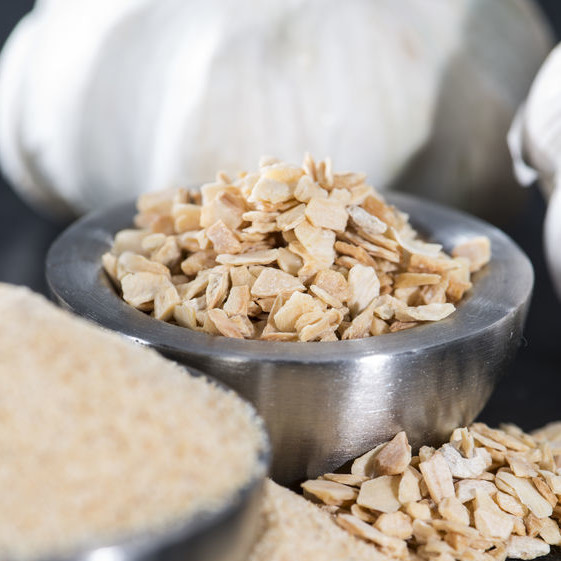
Dehydrated Garlic
Also known as powdered garlic
What is Dehydrated Garlic?
Dehydrated garlic is the dry powder obtained from garlic bulbs. It is characterized by a pungent and pleasant flavor, characteristic of the compound allicin. Garlic products are used for culinary and medical purposes. In baking, it’s added to breads, rolls, pizza and other savory goods.1
Dehydrated garlic can be found in a broad variety of forms such as:1
- Slices: particle size smaller than 4 mm
- Flakes or pieces: particle size between 1.25 – 4 mm
- Grits: particle size between 0.25 – 1.25 mm
- Powdered garlic: particle size 0.25 mm or smaller
Origin
Garlic (Allium sativum L.) dates back to Ancient Egyptian times over 4000 years ago. The crop is thought to have originated in Central Asia and Southern Europe. This ancient bulb crop was carried to the western hemisphere by the Spanish, Portuguese and French expeditions.1
Garlic crop is the second most important and widely cultivated Allium crop after onion. Currently, garlic is produced worldwide in most subtropical regions. China, India, Korea and Egypt are the main producers of garlic in the world.1
Function1,3
Garlic has many functions in baked goods:
- Flavor: provides a pungent and spicy flavor that tends to become sweet when cooked.
- Aroma: provides a pleasant characteristic aroma
- Texture: some dehydrated garlic varieties, especially minced or flaked, are considered inclusions and can provide a different texture or mouthfeel
- Staling: may retard staling due to its anti-fungal and antibiotic activities
- Hydration capacity: can slightly increase hydration capacity of wheat flour
- Dough stability: may affect dough stability while mixing and baking due to the presence of thiol compounds that may disrupt protein matrix
Nutrition1
Garlic has a high nutritional value compared to other bulb crops. It is rich in proteins, carbohydrates and minerals such as calcium, magnesium and potassium.The nutritional value of dehydrated garlic powder can be seen in the following table:
| Component | Grams |
| Moisture | 5.2 |
| Protein | 17.5 |
| Fat | 0.6 |
| Fibre | 1.9 |
| Carbohydrate | 71.4 |
| Minerals | 3.4 |
Garlic has been used throughout history for people with cardiovascular complications. Other benefits of garlic include its role in reducing cholesterol and lowering high blood pressure. Garlic can also aid in reducing the incidence of colon and stomach cancer. Allicin, the compound responsible for garlic’s flavor and aroma is throughout to be a powerful antioxidant.2
Commercial production1
Dehydrated garlic can be obtained through the following process:
- Washing: harvested bulbs are washed to remove contaminants
- Separation: cloves are separated and their skin removed
- Sterilization: cloves are sterilized by flame or alkali
- Size reduction: cloves are chopped and/or sliced
- Drying: garlic slices are dried with hot air at 60 °C (140°F) to reduce moisture content to approx. 8%
- Bin drying: garlic flakes are further dried down to 6.5% moisture with warm air
- Size reduction: flakes size can be reduced by passing through different size sieves to obtain a wide variety of dehydrated garlic products
Application1
Dehydrated garlic is used as a condiment in various baked goods. Mainly, garlic bread, croutons, rolls and pizza dough flavoring. Powdered garlic is usually added when garlic flavor is desired, while minced or flaked garlic is added for texture and mouthfeel to some baked goods. Also, it can be added during dough preparation with other ingredients or topically to the finished product.
Studies conducted by Hoseney et al, on the rheological properties of doughs containing garlic solids, have shown that addition of garlic to wheat flour doughs strongly decreases resistance to deformation and causes rapid breakdown during mixing. Similarly to aggressive reducing agents (e.g. L-cysteine, sorbic acid), adding garlic to bread formulations quickly results in diminished gas retention capacity which supposes a weakening effect on the gluten network.4
Just like other ‘sensitive’ ingredients used in breadmaking (e.g. citric acid, sorbic acid), encapsulation of garlic with a stable lipid matrix could be a possible solution for controlling the detrimental effects of garlic during mixing and proofing.
FDA regulations
Garlic and its derivatives such as dehydrated garlic are considered by the FDA generally recognized as safe flavoring agents.4
References
- Peter, K.V. Handbook Of Herbs And Spices Volume 1. 2nd ed., Woodhead Publishing Limited, 2012, pp. 299-314.
- Bauer,B.A ,Kermott,C.A and Millman,M.P. “MAYO CLINIC: The Integrative Guide to Good Health.” 1 st ed., Time Inc. Books, 2017.
- Kaur, K and Kaur,A . “Effect of supplementation of garlic and ginger powder on functional, rheological and bread making characteristics of wheat flour.” J Res Punjab Agric Univ 50 2013: 119-23.
- U.S. Department of Health and Human Services.” Direct Food Substances Affirmed As Generally Recognized As Safe”.Title 21 Code of Federal Regulation, pt. 184. April 2019. Available at https://www.accessdata.fda.gov/scripts/cdrh/cfdocs/cfcfr/CFRSearch.cfm?fr=184.1317. Accessed 10 Jun 2020.

